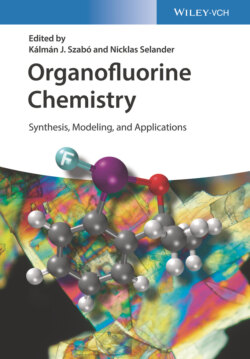Читать книгу Organofluorine Chemistry - Группа авторов - Страница 15
1.3.1 From Fluoroalkylation to Fluoroolefination
ОглавлениеA typical olefination reaction is started with a nucleophilic alkylation step (Scheme 1.11a). It is also true for fluoroolefination reactions. PhSO2CF2H is a powerful difluoromethylation reagent [26] and was studied extensively by us and others [5b, 27]. Inspired by the Julia–Kocienski reaction that uses heteroaryl sulfones for the synthesis of olefins [28], it is natural to envision whether a fluorinated version can be achieved for fluoroolefination. Indeed, by changing phenyl to 2‐pyridyl, we developed difluoromethyl 2‐pyridyl sulfone (2‐PySO2CF2H) as a novel and efficient gem‐difluoroolefination reagent [7a] (Scheme 1.11b).
Scheme 1.9 Synthesis and application of TFBz as a new trifluoromethoxylation reagent.
Scheme 1.10 The relationships among fluoroalkylation, fluoroolefination, and fluorination.
Scheme 1.11 The development of 2‐PySO2CF2H for gem‐difluoroolefination.
Notably, there is a unique fluorine effect in this olefination reaction. In non‐fluorinated Julia–Kocienski olefination reactions, 2‐pyridyl sulfones generally give lower yields of products than other heteroaryl sulfones, such as 1, 3‐benzothiazol‐2‐yl (BT), 1‐phenyl‐1H‐tetrazol‐5‐yl (PT), and 1‐tert‐butyl‐1H‐tetrazol‐5‐yl (TBT) sulfones [28]. However, the Julia–Kocienski type difluoroolefination reaction shows unusual reactivity: 2‐PySO2CF2H shows the highest reactivity, but PTSO2CF2H and TBTSO2CF2H possess almost no reactivity (Scheme 1.11c). This sharp contrast between 2‐PySO2CF2H and the other two reagents may be attributed to the much higher stability and better nucleophilicity of 2‐PySO2CF2− than other HetSO2CF2− anions. Another important feature of this reaction is that the sulfinate salt intermediate (Scheme 1.11d), which has never been observed in regular Julia–Kocienski reactions, was detected and captured by us for the first time, highlighting that organofluorine research enables intriguing insights into regular organic reactions.
Although an efficient gem‐difluoroolefination has been realized with 2‐PySO2CF2H, when it comes to monofluoroolefination, the issue of how to control the stereoselectivity arose.
In 2015, “a magic reaction” was discovered by us by the reaction of 2‐PySO2CHFR and aldehydes to prepare monofluoroalkenes [7c]. In this reaction, both Z‐ and E‐isomers can be obtained and easily separated in an efficient and stereoselective manner (Scheme 1.12a). The key issue of this unique reaction is the significant stability difference between the two diastereoisomeric sulfinate salt intermediates (Scheme 1.12b), which enables spontaneous resolution and phase labeling of the two diastereoisomeric sulfinate salts, thus allowing separation of Z‐ and E‐monofluoroalkenes by liquid–liquid extraction.
Scheme 1.12 Spontaneous resolution and phase separation to deliver Z‐ and E‐monofluoroalkenes.
The synthesis of terminal monofluoroalkenes was regarded as a formidable challenge because of the minimal energy difference between the two stereoisomers. Encouraged by the excellent stereocontrol in the fluoroalkylation of carbonyl compounds with chiral sulfoximine reagents [6c–e] and the efficient fluoroolefination with 2‐pyridyl sulfone reagents [7a] (Scheme 1.13a), we developed a novel heteroaryl sulfoximine reagent, S‐monofluoromethyl‐S‐(2‐pyridyl)sulfoximine, to access di‐ and trisubstituted terminal monofluoroalkenes with high stereoselectivity, concisely [6f] (Scheme 1.13b). The reaction proceeds through a highly diastereoselective addition of S‐monofluoromethyl‐S‐(2‐pyridyl)sulfoximine to carbonyls, followed by Smiles rearrangement and anti‐1, 2‐elimination (Scheme 1.13c). The 2‐pyridyl group plays a critical role in promoting the olefination, whereas the sulfoximidoyl group is pivotal for controlling the stereoselectivity.
Scheme 1.13 The development of S‐monofluoromethyl‐S‐(2‐pyridyl)sulfoximine for stereoselective monofluoroolefination.
